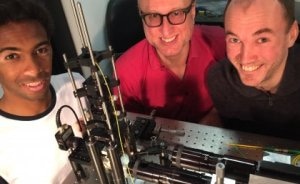Jun 28 2017
A diagnostic method capable of detecting very small molecules that indicate the presence of cancer could soon become a reality.
 UQ's Mr Nicolas Mauranyapin, Professsor Warwick Bowen and Dr Lars Madsen (credit: The University of Queensland)
UQ's Mr Nicolas Mauranyapin, Professsor Warwick Bowen and Dr Lars Madsen (credit: The University of Queensland)
The possibility of an entirely new capability for detecting cancer at its earliest stages arises from University of Queensland Physicists applying quantum physics to single molecule sensing for the first time.
Australian Research Council Future Fellow Professor Warwick Bowen said the research – recently reported in Nature Photonics – showed how quantum technologies could transform the study of life’s “nanoscale machinery, or biological motor molecules”.
Motor molecules encode our genetic material, create the energy our cells use to function, and distribute nutrients at a sub-cellular level. Unlike methods currently available, the technique helps us observe the behaviour of single biomolecules without large-label particles or damaging light intensities.
Professor Warwick Bowen, Australian Research Council Future Fellow
PhD student Nicolas Mauranyapin said motor molecules stimulated all of life’s key functions, but Researchers did not yet fully comprehend their workings.
“Our research opens a new door to study motor molecules in their native state, at the nanoscale,” Mr Mauranyapin said.
Project Researcher Dr Lars Madsen said the study applied methods applied to detect gravitational waves from black holes in outer space to the nanoscale – extremely small – world of molecular biology.
The techniques required to detect extremely faint signals produced by distant black holes were developed over decades. Our research translates this technological development over to the biosciences and offers the possibility of a new biomedical diagnostics technique capable of detecting the presence of even a single cancer marker molecule.
Dr Lars Madsen, Project Researcher
Researchers involved in the project are from five countries - New Zealand, Australia, France, Denmark and Pakistan.
The study is funded by the United States Air Force Office of Scientific Research, which aims to use the method to help comprehend stress on pilot behavior at the sub-cellular level.
The study is part of the University of Queensland Precision Sensing Initiative, a joint initiative of the schools of Mathematics and Physics and of Information Technology and Electrical Engineering.
It was supported by the ARC Centre of Excellence for Engineered Quantum Systems, which is focused on developing next-generation quantum technologies for future Australian industries.